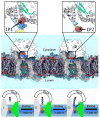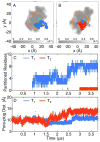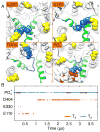Direct simulation of early-stage Sec-facilitated protein translocation
- PMID: 22852862
- PMCID: PMC3431202
- DOI: 10.1021/ja3034526
Direct simulation of early-stage Sec-facilitated protein translocation
Abstract
Direct simulations reveal key mechanistic features of early-stage protein translocation and membrane integration via the Sec-translocon channel. We present a novel computational protocol that combines non-equilibrium growth of the nascent protein with microsecond timescale molecular dynamics trajectories. Analysis of multiple, long timescale simulations elucidates molecular features of protein insertion into the translocon, including signal-peptide docking at the translocon lateral gate (LG), large lengthscale conformational rearrangement of the translocon LG helices, and partial membrane integration of hydrophobic nascent-protein sequences. Furthermore, the simulations demonstrate the role of specific molecular interactions in the regulation of protein secretion, membrane integration, and integral membrane protein topology. Salt-bridge contacts between the nascent-protein N-terminus, cytosolic translocon residues, and phospholipid head groups are shown to favor conformations of the nascent protein upon early-stage insertion that are consistent with the Type II (N(cyt)/C(exo)) integral membrane protein topology, and extended hydrophobic contacts between the nascent protein and the membrane lipid bilayer are shown to stabilize configurations that are consistent with the Type III (N(exo)/C(cyt)) topology. These results provide a detailed, mechanistic basis for understanding experimentally observed correlations between integral membrane protein topology, translocon mutagenesis, and nascent-protein sequence.
Figures




 , that partition into the membrane during the insertion simulations. (D) The time-evolution of the pore-plug distance in the insertion simulations.
, that partition into the membrane during the insertion simulations. (D) The time-evolution of the pore-plug distance in the insertion simulations.

Similar articles
-
Dynamics of Co-translational Membrane Protein Integration and Translocation via the Sec Translocon.J Am Chem Soc. 2020 Mar 25;142(12):5449-5460. doi: 10.1021/jacs.9b07820. Epub 2020 Mar 13. J Am Chem Soc. 2020. PMID: 32130863 Free PMC article. Review.
-
Long-timescale dynamics and regulation of Sec-facilitated protein translocation.Cell Rep. 2012 Oct 25;2(4):927-37. doi: 10.1016/j.celrep.2012.08.039. Epub 2012 Oct 19. Cell Rep. 2012. PMID: 23084746 Free PMC article.
-
Partially inserted nascent chain unzips the lateral gate of the Sec translocon.EMBO Rep. 2019 Oct 4;20(10):e48191. doi: 10.15252/embr.201948191. Epub 2019 Aug 5. EMBO Rep. 2019. PMID: 31379073 Free PMC article.
-
Forces on Nascent Polypeptides during Membrane Insertion and Translocation via the Sec Translocon.Biophys J. 2018 Nov 20;115(10):1885-1894. doi: 10.1016/j.bpj.2018.10.002. Epub 2018 Oct 10. Biophys J. 2018. PMID: 30366631 Free PMC article.
-
The Sec translocase.Biochim Biophys Acta. 2011 Mar;1808(3):851-65. doi: 10.1016/j.bbamem.2010.08.016. Epub 2010 Aug 27. Biochim Biophys Acta. 2011. PMID: 20801097 Review.
Cited by
-
Dynamics of Co-translational Membrane Protein Integration and Translocation via the Sec Translocon.J Am Chem Soc. 2020 Mar 25;142(12):5449-5460. doi: 10.1021/jacs.9b07820. Epub 2020 Mar 13. J Am Chem Soc. 2020. PMID: 32130863 Free PMC article. Review.
-
Reconciling the roles of kinetic and thermodynamic factors in membrane-protein insertion.J Am Chem Soc. 2013 Feb 13;135(6):2291-7. doi: 10.1021/ja310777k. Epub 2013 Jan 31. J Am Chem Soc. 2013. PMID: 23298280 Free PMC article.
-
Peptide Folding in Translocon-Like Pores.J Membr Biol. 2015 Jun;248(3):407-17. doi: 10.1007/s00232-015-9808-7. Epub 2015 May 28. J Membr Biol. 2015. PMID: 26016471
-
Native states of fast-folding proteins are kinetic traps.J Am Chem Soc. 2013 Mar 27;135(12):4729-34. doi: 10.1021/ja311077u. Epub 2013 Mar 15. J Am Chem Soc. 2013. PMID: 23458553 Free PMC article.
-
Energy landscape underlying spontaneous insertion and folding of an alpha-helical transmembrane protein into a bilayer.Nat Commun. 2018 Nov 23;9(1):4949. doi: 10.1038/s41467-018-07320-9. Nat Commun. 2018. PMID: 30470737 Free PMC article.
References
Publication types
MeSH terms
Substances
Grants and funding
LinkOut - more resources
Full Text Sources
Other Literature Sources

